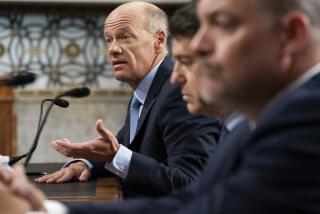As Big Guys Gobble the S&Ls;, Let Them Pay Their Dues
- Share via
The Bush team leaped before it looked when it suggested nicking savings-and-loan depositors for the sins of S&L; management, and got burned as a result. But in its fallback plan it didn’t have far to look to spot the takeover operators as the targets for the Treasury to hit first.
All S&Ls;, like Caesar’s Gaul, are divided into three parts: those already put out of their misery and handed over to new owners, those slowly twisting in the wind before being blown away, and survivors.
If President Bush directs the Treasury’s zeal against the savings-and-loans, he can invite the electorate, Congress and the media to spend the next four years reading his lips without a peep of protest against hidden taxes levied on S&L; depositors. The S&Ls; already taken over have no stockholders who might complain, only proprietors keeping the goodies to themselves. They would not retaliate by threatening a mortgage lenders’ strike. Their purpose in buying S&Ls; is not to make mortgage loans.
The new proprietors evaluated the defunct S&Ls; auctioned off to them as tax havens, not as investment opportunities. All of them put up peanuts to pick up push-carts full of assets. None of them need to worry a hoot about local real-estate conditions, values or credit risks around the country. All of them have been buying--more precisely, accepting--rich shelter from taxes already paid on their own past earnings, as well as from taxes to be owed on future earnings.
The President’s advisers believe in the “efficient market theory.” It has dictated a parallel White House decision to designate the banks as the country’s future community mortgage lenders. Before the fuss started over charging S&L; depositors and sparing the owners, operators with market smarts spotted the connection that the sponsors of the two-bit deposit assessment overlooked. Anyone buying S&Ls; was getting an option to sell to eager bank bidders.
So, on top of the tax benefits that they could count before they put their purchase money up, the new S&L; owners can also bank--no pun intended--on takeover bids from banks at prices that they can set themselves. Obviously only the bigger and better banks can or will bid, and they will bid against one another. Their targets will be local franchises to take deposits,not the challenge to revitalize real-estate markets in remote neighborhoods; S&L; passbooks draw the lowest interest rates in sight, and bank credit cards marketed to depositors earn the highest. Efficient market theory assumes that, given today’s high risk in mortgage lending, banks will seek deposits but hold back on mortgage loans. “Name” banks have been feeling their way toward going national for years. Thanks to the disastrous consequences of diversification of the S&Ls; into commercial banking, the opportunity is coming to them faster than they dared hope, and as benefactors, not predators. The name banks will happily pay top dollar for all the S&Ls; that they can gobble up. By the time they do, the FDIC, which insures their deposits, will long since have taken over from the FSLIC, which no longer has the wherewithal to insure S&L; deposits. The efficient market theory has already dictated this decision.
What about the second group of S&Ls;, the endangered ones? They’re barely making it, subject to the danger that any new burden would whip up another storm and leave them its orphans. True, the calendar cut-off stopped further giveaways of tax benefits at the turn of the year, and Congress is not likely to renew the hunting season. Nevertheless, two considerations argue for extending insurance assessments to this second group of shaky S&Ls.;
One is that the banks are now “in play,” as they say in the takeover game, as bride-grooms ready to rescue any S&Ls; cast as damsels in distress. The incidental one is that Federal Reserve Chairman Alan Greenspan has already put endangered S&Ls; on notice of their serious exposure to a jump in interest rates, which would hurt them more than a charge for deposit insurance. The Treasury admits that each full-point increase in rates will raise the S&L; bailout tab, and therefore the government spending that Greenspan deplores, by another $12 billion to $15 billion.
Finally, the profitable S&Ls; are in a class by themselves. The bidding contest that the banks are positioned to start for S&Ls; that are under water or merely treading it will jump market valuations of S&Ls; still going full steam ahead. The genuinely profitable S&Ls; are enjoying the best of both worlds: worst case, can’t lose; best case, big win. They will attract the first and the highest bank bids.
The sooner the S&Ls; cut off the argument about who is to foot the bill for insuring S&L; deposits, and volunteer to do so, the more depositors they will have to turn over to the banks. The banks will judge the cost a bargain. A little birdie has belatedly tipped off the White House staff to this fact of financial politics. Efficient market theory invites a try at passing along hidden costs.
More to Read
Inside the business of entertainment
The Wide Shot brings you news, analysis and insights on everything from streaming wars to production — and what it all means for the future.
You may occasionally receive promotional content from the Los Angeles Times.










